Scythe betting... marathons of our fields?
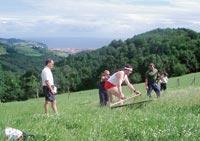
In November 2001 Juan Manuel Erasun came to us. On 14 July 2002 he had to compete with Bixente Mitxelena in the Piqueta de Oiartzun. It
was a traditional bet, that is, a two-hour competition in which the followers had to cut the grass as much as possible and, subsequently, the crew of each reaper was in charge of collecting and weighing the grass.
What Erasun asked us was a challenge for us. In fact, very little research has been done on the physical characteristics of kirolak herri athletes, and we had little practice in the field of mowing.
This lack of knowledge led us to ask ourselves many questions and, in order to respond to them, we started collecting data. To begin with, we had to know what the physiological needs of two hours of mowing are. We also had to know the physical state of Diseases. For this we use different physical tests.
The third step was to organize the work. We had clear that, in addition to the controllable variables, the uncontrollable ones would also have
a lot of influence on the day of the bet: nervousness, state of the grass, time… But until July we had a period of eight months to prepare Erasun. With us we had a follower of 40 years, 180 centimeters long and 91 kilos of weight, mesomorphic morphology and with a maximum estimated oxygen consumption of 47.9 ml/k/min. He was a veteran athlete in two hours of challenges.
Resistance and strength
We begin to know the physiological bases of mowing. First we control the specific parameters. Among other things, we measure muscle fatigue and heart rate, and from there we plan the preparation to get the best physical shape.

As for us it was a new activity, we had to compare it with something and knowing it was a two-hour exercise, we equated it to the marathon. That is, we thought that they would continue to demand a high level of resistance and that force would be a secondary component.
But over time we realized that we were wrong. We saw that not everything was resistance, that strength was also essential. And it is that in the marathon the legs work, but in the reed the upper part of the body has a total participation, and to give persecutions it takes strength. So we had to work hard and we used to go to the gym three times a week.
In addition, we had to work the resistance. Other segalaris run or walk on the mountain. That's not bad, because it helps to be in shape, but we thought it should be followed to work the specific resistance. The same goes for other sports, for example, before cyclists did not cycle in winter, but then they saw that to train well they had to ride a bicycle. Erasun also had to follow.
How? The riders have a treadmill, the rowers a rowing ergometer and the cyclists a cycle ergometer, but the segalaris do not have a special machine that symbolizes the scythe. And in winter there is no grass in the fields...
The solution was as original as it was successful: we trained on the beach. In the Zurriola, once the tide is down, there is a very fine sand, and when we created the hills with our hand, we cut them to Erasun with an old sega. It may seem like an eccentricism and we have ridiculous passages as if on the eve of San Sebastian an Argentine approached us asking if it was a typical activity of that day. What happens is that then it became clear that training in sand is very useful for later in the field.
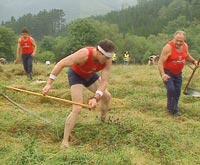

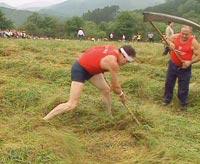


Physical tests
Along with this, as in other sports, we had to do progressive tests. In these tests the intensity of the effort increases to reach the maximum effort.
The progressive tests consist of measuring the heart rate at different levels of intensity and extracting a drop of blood to measure the lactate concentration. These physical tests are performed both in the laboratory and in the place where the sport is practiced and the results are very useful to know the situation of the athlete. In addition, they help determine the rhythms to use in workouts.
Since there was no continuity protocol, we created our own tests, one with progressive intensity and one stable. The progressive included series of 5 minutes at different rhythms, from 30 to 31 beats per minute to 2 strokes per minute of series to exhaust the mower. Between the series we made a minute of rest to draw a drop of blood from the ear and measure the concentration of lactate. We also record heart rate every 5 seconds by one pulsometer.
Months later, after many trainings, we did the tests again to check the physiological changes.
In the absence of four weeks for the challenge, we agreed to perform a stable test to measure
the physiological work of the meeting and confirm that the expected rhythms were adequate. Otherwise, we would have the opportunity to readjust the rhythms and get to the challenge day in the best physical condition.
This test was a gamble test. We set the pace of the bet and recorded the lactate (every 30 minutes), heart rate (every 5 seconds) and rhythm data (every 5 minutes).
As mentioned above, at first it looked like a marathon, but after a stable test we found that it was not so. The lactate concentrations of Maratonians are much lower because they use oxygen throughout the test. Our follower, for his part, had a higher lactate level throughout the session, indicating that strength is more important than in the marathon.
Bet, real test
The weeks passed fast and came the day of the bet. He won Erasun, although the difference was small. But it was clear to us that we were on the right track. In addition, it was cited for the following year: The bet will be held on August 17, 2003 at the Garate de Andoain campas. And thanks to the work done until then, we knew how to prepare Erasun to win that bet.

that moved from one terrain to another, that is, once a stretch is finished, it corresponds
to the time it took to go to the section to cut.
We defined and refined trainings and tests, and Erasun had more confidence in us. We work with hope and, as in 2002, we did the test eight weeks before the betting day. Then we checked that it was ready.
The day of the competition came. As in the previous year, Erasun had a pulse monitor to measure heart rate and to measure rhythm. We compared the 2002 data. Unfortunately we could not measure lactate, since competition can not stop to draw the blood sample. If we had this data, we would have a more precise knowledge of the physiological situation, but as it is not possible, we had to draw conclusions with other parameters.
Comparing the data of the two years, a remarkable improvement of resistance is observed from year to year. It was no wonder that, as a result of the previous year's training, the season began better. But the pulse data surprised us. According to the physiological tests we did, we expected the heart rate to be lower and the opposite occurred.
Uncontrollable variables
To explain it, we analyze different hypotheses. Undoubtedly, uncontrollable variables such as time could have a great influence. On the other hand, the technical variables, such as the state of the grass and the aspect of the prairie, have a great importance. And, in our opinion, they were the ones that caused the heartbeat, since the Garate field was on the slope. In contrast, the year before, that of Pikoka, was flat.
In addition to the variables mentioned, we must not forget other variables. There are, among other things, the work of the gang that collects the psychological situation and the grass cut.
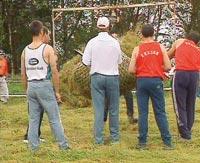
The main conclusion was that segalari cannot be equated to Maratonian. The mowing has special characteristics and does not seem to run in marathon. The concentration of lactate in blood is a test of the enormous importance of strength in addition to resistance. The concentrations that we measured to Erasun in the tests would be too high for a marathon, concentration that could not end. Erasun, meanwhile, ended the bet well.
Now we know that pursuing is a special activity, that strength is very important and that tests and training prepared by Osasunkirolak are suitable. However, it must be clarified that these tests and tests were adapted to the physical state of the Diseases and that for an athlete who is not so well in shape would have to lower the rhythms.
As for Erasun, he won both bets. So we met the goal.
Physical exercise and lactate
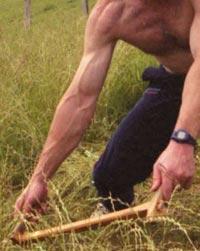
In long-term physical exercise, muscles work at low intensity and have an aerobic metabolism. This means they use oxygen as fuel. If the intensity increases, the muscles use other fuels and the anaerobic metabolism comes into play. This metabolism produces lactate, so the blood concentration of lactate serves to determine when the metabolism has gone from being aerobic to being anaerobic.
For sports physiologists it is important to know the lactate concentration. Depending on the lactate concentration, the physiologist knows the type of work done by the muscle.
Bangsbo, J. Lindquist, F. Fohrenbach, R. Mader, A. Hollmann, W. Padilla, S., Mujika, I. Slope, G., Polo, J.M. Chatard, J.C. |





